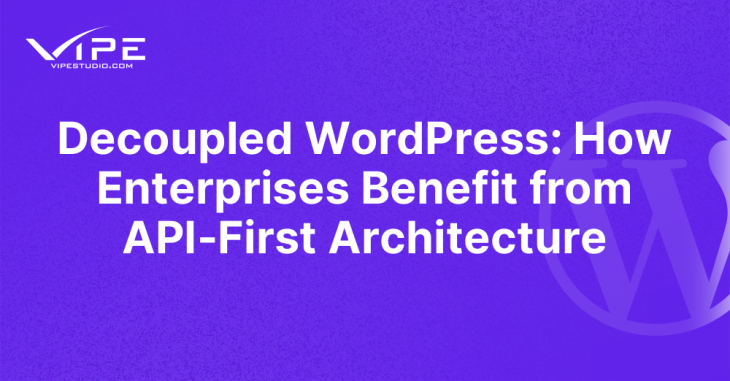Decoupled WordPress: How Enterprises Benefit from API-First Architecture

READING TIME: MIN
As enterprise organizations demand more flexibility, speed, and integration across digital channels, traditional monolithic CMS platforms are no longer sufficient. WordPress, when used in a decoupled or headless configuration, enables businesses to build API-first architectures that meet modern user expectations and integrate seamlessly into complex ecosystems.
Understanding the Concept of Headless and Decoupled WordPress
In a traditional WordPress setup, the backend (where content is created) and frontend (where it’s displayed) are tightly coupled. A decoupled or headless WordPress configuration separates these two layers. The WordPress backend handles content management, while APIs—typically REST or GraphQL—deliver content to any frontend framework, such as Next.js or React.
This separation opens up new possibilities for performance, scalability, and multichannel content delivery, essential for enterprise-level projects.

Why Decoupled WordPress Enhances Speed and Performance at Scale
When the frontend is handled by a modern JavaScript framework, enterprises gain the ability to build lightning-fast websites and applications. Frameworks like Next.js enable features like static site generation and server-side rendering, greatly improving load times and SEO.
This performance boost can be critical in retaining users and improving conversion rates—especially for businesses with a global audience and high traffic demands.
Multi-Channel Content Delivery for Consistent Brand Messaging
One of the standout advantages of using WordPress in a headless setup is the ability to reuse and syndicate content across multiple channels. From websites to mobile apps, smart devices, or digital signage—API-first delivery ensures your content stays consistent and up-to-date wherever it’s viewed.

At Vipe Studio, we help enterprises architect headless WordPress platforms that serve a wide range of content consumers through a unified backend.
Improved Developer Experience and Customization Flexibility
Front-end developers are no longer bound by the limitations of PHP templates or WordPress themes. They can use modern JavaScript frameworks, version control, CI/CD pipelines, and component-based design systems to build tailored interfaces that reflect enterprise brand identities and UX goals.
Integrating Enterprise Systems Using REST and GraphQL APIs
Headless WordPress enables smooth integration with CRMs, ERPs, marketing automation platforms, and custom internal systems. APIs facilitate secure and real-time data exchange, making WordPress a powerful content hub rather than a siloed CMS.

To see how we implement such architectures, request a personalized consultation with Vipe Studio’s enterprise development team.
Future-Proofing Your Digital Infrastructure
Technology evolves fast. An API-first approach ensures that your content layer is ready for future platforms—whether it’s a new frontend technology, a voice assistant, or a new form of media display. With decoupled WordPress, your business retains control and agility without being locked into one frontend solution.
Conclusion: Unlocking Next-Generation Capabilities with Headless WordPress
For enterprises seeking high performance, omnichannel reach, and seamless integrations, decoupled WordPress provides the agility needed to compete in a digital-first world. By separating the content engine from the presentation layer, organizations can innovate faster, deliver better user experiences, and scale without limits.

Vipe Studio is your partner in building robust headless WordPress platforms customized for enterprise needs. Let’s bring your API-first vision to life.
More on The Topic
- The Hidden Economy of Plugins: Who Really Controls WordPress?
- The Future of WordPress Agencies: Are We Becoming Platform Engineers?
- The Ghost Developer: Building Sites You’ll Never Touch Again
- Custom Post Types: Unlocking WordPress Beyond Blogs
- Digital Monuments: How to Build WordPress Sites That Will Outlive You

